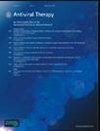Efficacy of second-line dolutegravir plus 2 nucleoside reverse transcriptase inhibitors by baseline nucleoside reverse transcriptase inhibitor resistance and nucleoside reverse transcriptase inhibitor use in the DAWNING study
IF 2.3
4区 医学
Q4 INFECTIOUS DISEASES
引用次数: 1
Abstract
Background In the DAWNING study, dolutegravir + 2 nucleoside reverse transcriptase inhibitors (NRTIs) demonstrated superior efficacy at Week 48 and a favourable safety profile compared with lopinavir/ritonavir + 2 NRTIs in adults with HIV-1 failing first-line therapy of a non-nucleoside reverse transcriptase inhibitor + 2 NRTIs. Methods Participants at 58 centres in 13 countries were randomised (1:1) to 52 weeks of open-label treatment with dolutegravir or lopinavir/ritonavir combined with 2 investigator-selected NRTIs, including at least one fully active NRTI based on screening resistance testing. The primary endpoint was the proportion of participants achieving HIV-1 RNA <50 copies/ml at Week 48 (Snapshot algorithm). Post-hoc efficacy analyses were performed based on baseline NRTI resistance profile and second-line NRTI use. Results Of 624 participants randomised and treated, 499 (80%) received <2 active NRTIs at Baseline. NRTI resistance was present in 561 participants (90%). Among participants receiving lamivudine or emtricitabine in the presence of M184V/I, 85% (187/220) of participants on dolutegravir versus 72% (152/210) on lopinavir/ritonavir had HIV-1 RNA <50 copies/ml at Week 48 (difference, 12.6%; 95% CI: 4.9–20.3%). High responses were also observed in the dolutegravir group, when zidovudine or tenofovir disoproxil fumarate were included in the background regimen in the presence of thymidine analogue mutations or K65R, respectively; however, participant numbers in these subgroups were small. Conclusions Response rates were high in participants receiving dolutegravir + 2 NRTIs as second-line treatment regardless of pre-existing resistance to one of the NRTIs, including in participants using lamivudine or emtricitabine in the presence of M184V/I.DAWNING研究中基线核苷逆转录酶抑制剂耐药性和核苷逆转录酶抑制物使用的二线多卢替拉韦加2种核苷逆转录酶拮抗剂的疗效
背景在DAWNING研究中,与洛匹那韦/利托那韦+2个核苷逆转录酶抑制剂相比,多卢替拉韦+2个核苷类逆转录酶抑制剂(NRTIs)在成人HIV-1非核糖核酸酶抑制剂+2个NRTIs一线治疗失败的患者中,在第48周表现出优越的疗效和良好的安全性。方法将来自13个国家58个中心的参与者随机(1:1)接受为期52周的开放标签治疗,使用多卢替拉韦或洛匹那韦/利托那韦联合2种研究者选择的NRTI,包括至少一种基于筛选耐药性测试的完全活性NRTI。主要终点是在第48周达到HIV-1 RNA<50拷贝/ml的参与者比例(快照算法)。根据基线NRTI耐药性和二线NRTI使用情况进行事后疗效分析。结果在624名随机接受治疗的参与者中,499人(80%)在基线时接受了<2次活性NRTI。561名参与者(90%)存在NRTI耐药性。在M184V/I存在下接受拉米夫定或恩曲他滨治疗的参与者中,在第48周,85%(187/220)的参与者服用多卢替韦,而72%(152/210)的服用洛匹那韦/利托那韦的参与者HIV-1 RNA<50拷贝/ml(差异12.6%;95%CI:4.9-20.3%),当分别在胸苷类似物突变或K65R存在的情况下将齐多夫定或富马酸替诺福韦二酯包括在背景方案中时;然而,这些亚组的参与者人数很少。结论接受多卢替拉韦+2次NRTIs作为二线治疗的参与者,无论对其中一种NRTIs是否存在耐药性,包括在存在M184V/I的情况下使用拉米夫定或恩曲他滨的参与者,有效率都很高。
本文章由计算机程序翻译,如有差异,请以英文原文为准。
求助全文
约1分钟内获得全文
求助全文
来源期刊

Antiviral Therapy
医学-病毒学
CiteScore
2.60
自引率
8.30%
发文量
35
审稿时长
4-8 weeks
期刊介绍:
Antiviral Therapy (an official publication of the International Society of Antiviral Research) is an international, peer-reviewed journal devoted to publishing articles on the clinical development and use of antiviral agents and vaccines, and the treatment of all viral diseases. Antiviral Therapy is one of the leading journals in virology and infectious diseases.
The journal is comprehensive, and publishes articles concerning all clinical aspects of antiviral therapy. It features editorials, original research papers, specially commissioned review articles, letters and book reviews. The journal is aimed at physicians and specialists interested in clinical and basic research.
 求助内容:
求助内容: 应助结果提醒方式:
应助结果提醒方式:


